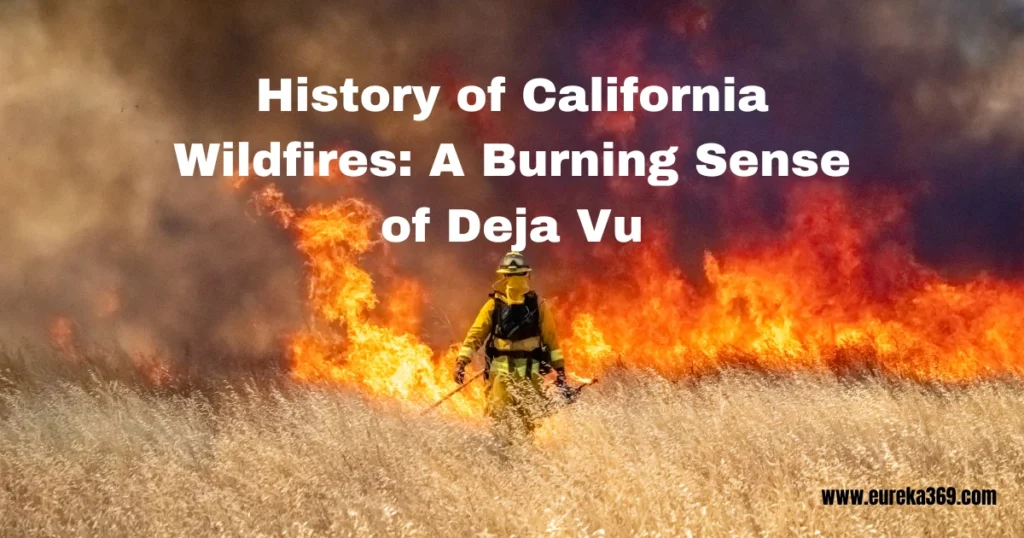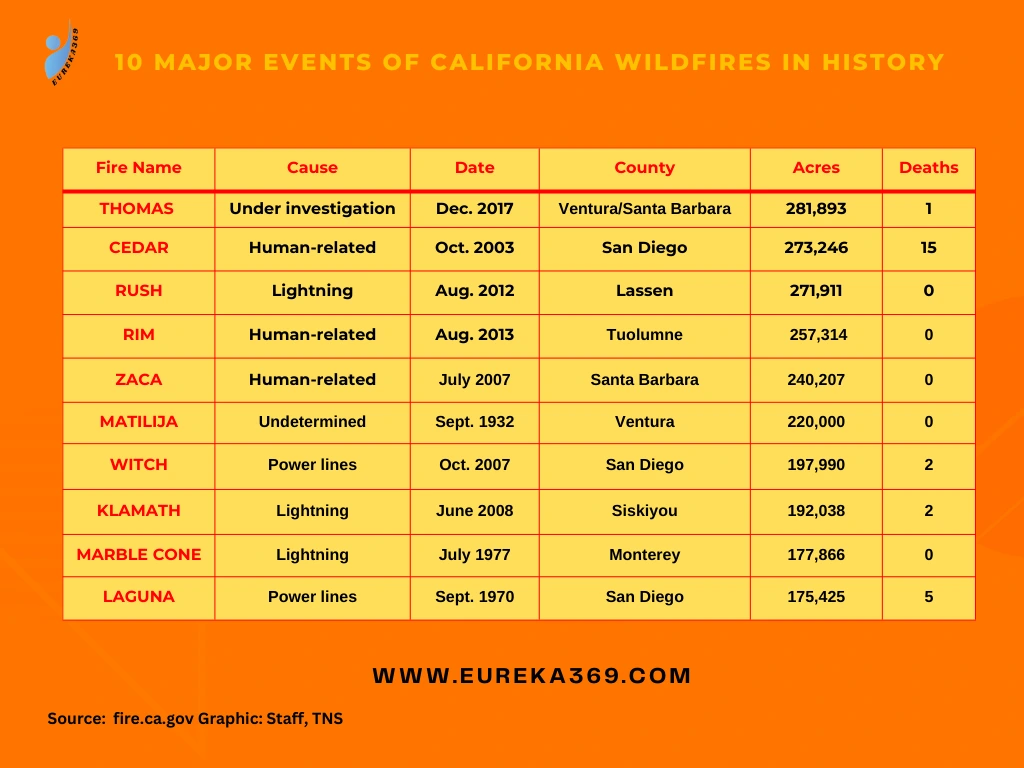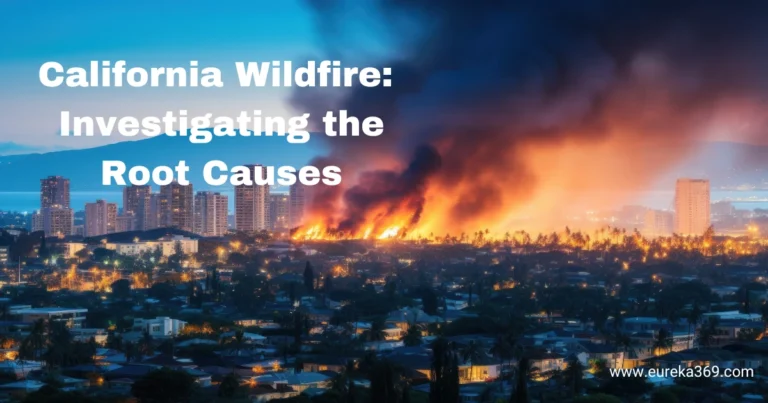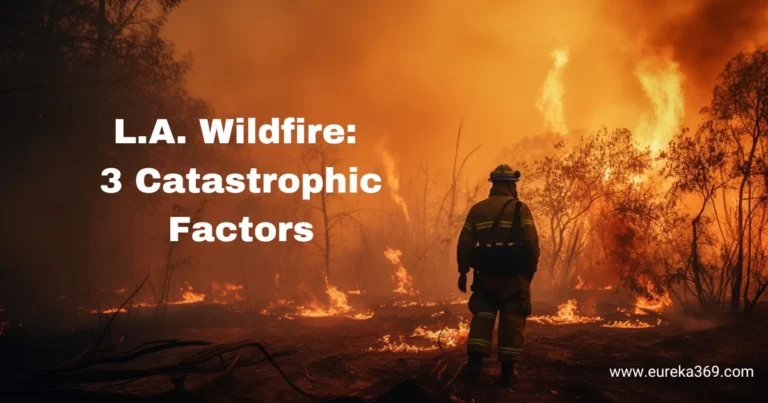“The El Dorado Fire of 2020 was sparked by a pyrotechnic device at a gender reveal party, highlighting the unpredictable nature of human-caused fires.”

California wildfires have been a recurring and devastating phenomenon throughout the state’s history. Over the past century, these fires have grown in frequency and severity, impacting numerous communities and ecosystems.
As we examine history of California wildfires, it is clear that these events have been shaped by a combination of natural factors, such as drought and wind, and human activities, including land development and climate change. For instance, the Bel Air Fire of 1961, fueled by strong Santa Ana winds, destroyed over 900 homes in Los Angeles, highlighting the destructive potential of wildfires in urban areas.
Similarly, the Cedar Fire of 2003, which burned for 14 days, resulted in the loss of more than 2,800 homes and 15 lives, underscoring the need for effective fire management strategies. These incidents demonstrate the escalating risk and impact of wildfires across California.
“California wildfires will become more extreme, frequent, and widespread due to ongoing warm air temperatures and variable precipitation.“
Amy Hessl, Paleo climatologist, West Virginia University
She highlights the role of Santa Ana winds in exacerbating fire conditions in Southern California. We will now explore the 100 years history of California wildfires and its main causes.
Historical Overview of Major California Wildfires
Even though, the earliest recorded wildfire in California was the Santiago Canyon Fire of 1889, which burned approximately 300,000 acres across Orange, San Diego, and Riverside counties. This event set the stage for what would become a persistent threat to California’s landscapes and populations. We will now discuss the major events that caused immense devastation and have a deeper impact of a climate change.
The Berkeley Fire (1923)
Cause: Human-Related Ignition
It was a pivotal event in the history of California wildfires, marking the beginning of modern wildfire documentation. On September 17, 1923, a devastating fire swept through the hills above Berkeley, fueled by strong winds and dry conditions. The fire began in Wildcat Canyon and quickly spread into the city, driven by fierce Santa Ana-like winds, which were unusually strong for the region.
The disaster destroyed nearly 600 structures, leaving over 4,000 people homeless, yet miraculously resulted in no fatalities. The fire highlighted critical issues such as inadequate fire breaks, insufficient water supply, and overcrowding in residential areas. This incident prompted significant changes in fire prevention and management strategies, laying the groundwork for organized fire prevention methods in California. Despite these advancements, similar wildfire scenarios have continued to occur, underscoring the ongoing challenges in managing and mitigating wildfires in the state.
The Griffith Park Fire (1933)
Cause: Unknown
The Griffith Park Fire of 1933 was one of the earliest significant wildfires in California’s recorded history. It burned for four days and caused an estimated $1.5 million in damage. This fire marked an early instance of urban wildfires affecting densely populated areas. Although it did not destroy any structures, it highlighted the potential for wildfires to impact urban environments.
The Griffith Park Fire serves as a precursor to the more destructive events that would follow in the history of California wildfires. It underscores the importance of early fire prevention and response strategies, especially in urban areas where human lives and property are at risk.
The Bel Air Fire (1961)
Cause: Strong Santa Ana Winds
The Bel Air Fire of 1961 stands out as a pivotal event in California’s wildfire history. Fueled by strong Santa Ana winds, it destroyed more than 900 homes in the Bel Air neighborhood of Los Angeles. This disaster highlighted the vulnerability of urban areas to wildfires, especially when exacerbated by weather conditions. As history of California wildfires have shown, such fires are not isolated incidents but part of a broader pattern of increasing risk due to climate change and urban expansion.
The Bel Air Fire led to significant changes in fire safety regulations and emergency preparedness in California. It emphasized the need for proactive measures to prevent and mitigate wildfires, particularly in areas prone to strong winds and dry conditions.
The Oakland Hills Fire (1991)
Cause: Rekindle of a Previous Fire
In 1991, the Oakland Hills Firestorm caused devastating damage, killing 25 people and destroying over 3,000 homes. This tragedy was caused by a combination of dry conditions and strong winds, similar to many other wildfires in the state. The Oakland Hills Fire highlighted the importance of community preparedness and the need for effective emergency response systems.
The fire also underscored the role of climate and weather conditions in exacerbating wildfires. It led to increased awareness about the risks associated with living in fire-prone areas and the importance of maintaining defensible space around homes.
The Cedar Fire (2003)
Cause: Human-Related Ignition
The Cedar Fire of 2003 was one of the largest wildfires in California’s history at the time, burning for 14 days and destroying more than 2,800 homes. It resulted in 15 fatalities and highlighted the need for robust fire management strategies, including early detection and rapid response.
This fire demonstrated the potential for wildfires to spread rapidly in dry conditions, emphasizing the importance of public awareness and cooperation in preventing human-caused fires. The Cedar Fire also led to improvements in firefighting techniques and the use of advanced technology to combat wildfires.
The Camp Fire (2018)
Cause: Faulty Power Line
The Camp Fire of 2018 marked a grim milestone as the deadliest wildfire in California history, claiming 85 lives and destroying over 18,000 structures. This disaster underscored the critical need for enhanced fire prevention and response strategies. As experts note, the increasing severity of wildfires is linked to climate change, which exacerbates dry conditions and fuels more intense fires.
The Camp Fire led to significant policy changes and investments in wildfire prevention and mitigation. It highlighted the importance of addressing climate change and implementing sustainable land management practices to reduce the risk of wildfires.
Recent Wildfires in Los Angeles (2025)
Cause: Possibly Climate Change
In January 2025, a series of intense wildfires swept through the Los Angeles area, driven by arid conditions and powerful Santa Ana winds. The Palisades Fire, Eaton Fire, and Hurst Fire were among the most significant, with the Palisades Fire burning over 20,438 acres and the Eaton Fire affecting more than 7,000 structures. These fires resulted in significant evacuations and highlighted the ongoing threat of wildfires in urban areas.
The 2025 wildfires in L.A. underscore the need for continued vigilance and proactive measures to address the escalating risk of wildfires. They demonstrate how history of California wildfires have evolved to become more frequent and destructive, necessitating robust emergency response systems and community preparedness. Below are the major incidents in the history of California wildfires:

Factors Contributing to California Wildfires
Climate Change and Drought
Climate change plays a significant role in the increasing frequency and severity throughout the history of California wildfires. Rising temperatures and changing precipitation patterns lead to prolonged droughts, creating ideal conditions for wildfires to ignite and spread rapidly. For example, the 2020 wildfire season was the largest on record, with over 4 million acres burned, largely due to a severe drought and extreme heat waves. This trend is expected to continue as global warming intensifies, making California’s ecosystems more susceptible to devastating fires.
Experts emphasize that climate change not only dries out vegetation but also alters weather patterns, leading to more frequent and intense heat waves and wind events. These conditions, combined with human activities such as land development in fire-prone areas, have created a perfect storm for wildfires. As noted by environmental analysts, the situation is “entirely foreseeable,” given the combination of climate factors and human actions. Therefore, addressing climate change is essential for reducing the risk of California wildfires in 100 years.
Human Activity and Land Development
Human activity, particularly urban expansion into fire-prone areas, significantly contributed to the risk and impact through the history of California wildfires. Suburban sprawl into wildland-urban interfaces increases the likelihood of wildfires affecting populated areas. The Bel Air Fire of 1961 and more recent fires, such as the Woolsey Fire in 2018, demonstrate how development in high-risk zones can lead to catastrophic outcomes. Experts warn that continued development in these areas will only exacerbate the problem, as seen in the recent Los Angeles fires, which were anticipated due to the combination of urban expansion and climatic conditions.
Furthermore, human ignitions, whether accidental or intentional, are a common cause of wildfires. For instance, the El Dorado Fire of 2020 was sparked by a pyrotechnic device at a gender reveal party, highlighting the unpredictable nature of human-caused fires. As the history of California wildfires continue to pose a significant threat, it is crucial to implement stricter regulations and public awareness campaigns to prevent such incidents.
Economic and Environmental Impact
Economic Costs
The economic toll of California wildfires in 100 years is substantial. In recent years, the direct costs of firefighting, property damage, and lost economic activity have reached billions of dollars annually. For example, the 2020 wildfire season resulted in economic losses exceeding $1.23 billion, not including indirect costs such as long-term health impacts and environmental degradation. These financial burdens underscore the need for proactive measures to prevent and mitigate wildfires, as the economic benefits of prevention far outweigh the costs of response and recovery.
Moreover, the destruction of homes and businesses disrupts local economies and communities, leading to long-term recovery challenges. The Camp Fire, for instance, not only destroyed thousands of structures but also devastated the local economy of Paradise, California, requiring extensive rebuilding efforts. As California wildfires in 100 years continue to escalate, addressing these economic impacts will be essential for supporting affected communities.
Environmental Consequences
The environmental impact through the history of California wildfires is equally concerning. Wildfires can cause significant ecological damage, including the loss of biodiversity and alteration of ecosystems. The August Complex Fire of 2020, which burned over 1 million acres, exemplifies the scale of environmental destruction these fires can cause. Additionally, wildfires release large amounts of greenhouse gases, contributing to climate change and creating a vicious cycle that exacerbates future fire risks.
“Climate change contributes to the dryness of vegetation, making wildfires more intense. He emphasizes that while natural factors like strong winds and dry conditions are significant, climate change amplifies these conditions, leading to larger and more intense fires.”
Park Williams, Climate Scientist, UCLA’s Climate and Wildfire Research Initiative
Experts emphasize that preserving natural habitats and promoting ecosystem resilience are critical for mitigating the environmental effects of wildfires. This includes implementing sustainable land management practices and restoring burned areas to prevent erosion and promote biodiversity. As the history of California wildfires continue to pose a significant environmental threat, adopting these strategies will be essential for protecting California’s ecosystems. Do check out Los Angeles Wildfire 2025: Investigating the Root Causes, where we have investigated the root causes of the Inferno thoroughly. How it occurs and provided practical solutions to mitigate it. You can also check out Stories About Wildfires | 60 Minutes Full Episodes on YouTube or watch below:
Conclusion
History of California wildfires have evolved from occasional natural events to frequent and devastating disasters. The combination of climate change, human activity, and land development has created a volatile environment where wildfires can quickly spread and cause catastrophic damage. As we move forward, it is crucial to address these factors through proactive measures such as fire prevention, sustainable land use, and climate action. By understanding the history of California wildfires and current trends, we can work towards a safer and more resilient future for California’s communities and ecosystems.
Read more on California Wildfire 2025: 3 Devastating Forces Behind the Inferno. You might also like to know about the reasons of root causes and how to mitigate those factors: Los Angeles Wildfire 2025: Investigating the Root Causes



Leave a Reply